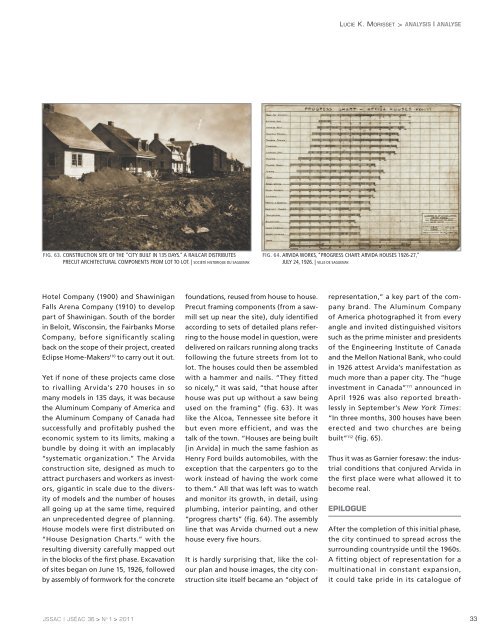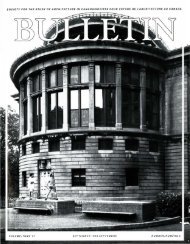'à es us e ct n s, es - Sexton Digtial Initiatives - Dalhousie University
'à es us e ct n s, es - Sexton Digtial Initiatives - Dalhousie University
'à es us e ct n s, es - Sexton Digtial Initiatives - Dalhousie University
You also want an ePaper? Increase the reach of your titles
YUMPU automatically turns print PDFs into web optimized ePapers that Google loves.
fig. 63. cOnstru<strong>ct</strong>iOn site Of the “city built in 135 dAys.” A rAilcAr distribut<strong>es</strong><br />
Precut Archite<strong>ct</strong>urAl cOmPOnents frOm lOt tO lOt. | sOciété histOrique du sAguenAy.<br />
Hotel Company (1900) and Shawinigan<br />
Falls Arena Company (1910) to develop<br />
part of Shawinigan. South of the border<br />
in Beloit, Wisconsin, the Fairbanks Morse<br />
Company, before significantly scaling<br />
back on the scope of their proje<strong>ct</strong>, created<br />
Eclipse Home-Makers110 to carry out it out.<br />
Yet if none of th<strong>es</strong>e proje<strong>ct</strong>s came close<br />
to rivalling Arvida’s 270 ho<strong>us</strong><strong>es</strong> in so<br />
many models in 135 days, it was beca<strong>us</strong>e<br />
the Aluminum Company of America and<br />
the Aluminum Company of Canada had<br />
succ<strong>es</strong>sfully and profitably p<strong>us</strong>hed the<br />
economic system to its limits, making a<br />
bundle by doing it with an implacably<br />
“systematic organization.” The Arvida<br />
constru<strong>ct</strong>ion site, d<strong>es</strong>igned as much to<br />
attra<strong>ct</strong> purchasers and workers as inv<strong>es</strong>tors,<br />
gigantic in scale due to the diversity<br />
of models and the number of ho<strong>us</strong><strong>es</strong><br />
all going up at the same time, required<br />
an unprecedented degree of planning.<br />
Ho<strong>us</strong>e models were first distributed on<br />
“Ho<strong>us</strong>e D<strong>es</strong>ignation Charts.” with the<br />
r<strong>es</strong>ulting diversity carefully mapped out<br />
in the blocks of the first phase. Excavation<br />
of sit<strong>es</strong> began on June 15, 1926, followed<br />
by assembly of formwork for the concrete<br />
JSSAC | JSÉAC 36 > N o 1 > 2011<br />
foundations, re<strong>us</strong>ed from ho<strong>us</strong>e to ho<strong>us</strong>e.<br />
Precut framing components (from a sawmill<br />
set up near the site), duly identified<br />
according to sets of detailed plans referring<br />
to the ho<strong>us</strong>e model in qu<strong>es</strong>tion, were<br />
delivered on railcars running along tracks<br />
following the future streets from lot to<br />
lot. The ho<strong>us</strong><strong>es</strong> could then be assembled<br />
with a hammer and nails. “They fitted<br />
so nicely,” it was said, “that ho<strong>us</strong>e after<br />
ho<strong>us</strong>e was put up without a saw being<br />
<strong>us</strong>ed on the framing” (fig. 63). It was<br />
like the Alcoa, Tenn<strong>es</strong>see site before it<br />
but even more efficient, and was the<br />
talk of the town. “Ho<strong>us</strong><strong>es</strong> are being built<br />
[in Arvida] in much the same fashion as<br />
Henry Ford builds automobil<strong>es</strong>, with the<br />
exception that the carpenters go to the<br />
work instead of having the work come<br />
to them.” All that was left was to watch<br />
and monitor its growth, in detail, <strong>us</strong>ing<br />
plumbing, interior painting, and other<br />
“progr<strong>es</strong>s charts” (fig. 64). The assembly<br />
line that was Arvida churned out a new<br />
ho<strong>us</strong>e every five hours.<br />
It is hardly surprising that, like the colour<br />
plan and ho<strong>us</strong>e imag<strong>es</strong>, the city constru<strong>ct</strong>ion<br />
site itself became an “obje<strong>ct</strong> of<br />
Lucie K. Morisset > aNalysis | aNalyse<br />
fig. 64. ArvidA wOrks, “PrOgr<strong>es</strong>s chArt: ArvidA hO<strong>us</strong><strong>es</strong> 1926-27,”<br />
July 24, 1926. | ville de sAguenAy.<br />
repr<strong>es</strong>entation,” a key part of the company<br />
brand. The Aluminum Company<br />
of America photographed it from every<br />
angle and invited distinguished visitors<br />
such as the prime minister and pr<strong>es</strong>idents<br />
of the Engineering Institute of Canada<br />
and the Mellon National Bank, who could<br />
in 1926 att<strong>es</strong>t Arvida’s manif<strong>es</strong>tation as<br />
much more than a paper city. The “huge<br />
inv<strong>es</strong>tment in Canada” 111 announced in<br />
April 1926 was also reported breathl<strong>es</strong>sly<br />
in September’s New York Tim<strong>es</strong>:<br />
“In three months, 300 ho<strong>us</strong><strong>es</strong> have been<br />
ere<strong>ct</strong>ed and two church<strong>es</strong> are being<br />
built” 112 (fig. 65).<br />
Th<strong>us</strong> it was as Garnier for<strong>es</strong>aw: the ind<strong>us</strong>trial<br />
conditions that conjured Arvida in<br />
the first place were what allowed it to<br />
become real.<br />
epilogUe<br />
After the completion of this initial phase,<br />
the city continued to spread across the<br />
surrounding countryside until the 1960s.<br />
A fitting obje<strong>ct</strong> of repr<strong>es</strong>entation for a<br />
multinational in constant expansion,<br />
it could take pride in its catalogue of<br />
33

















